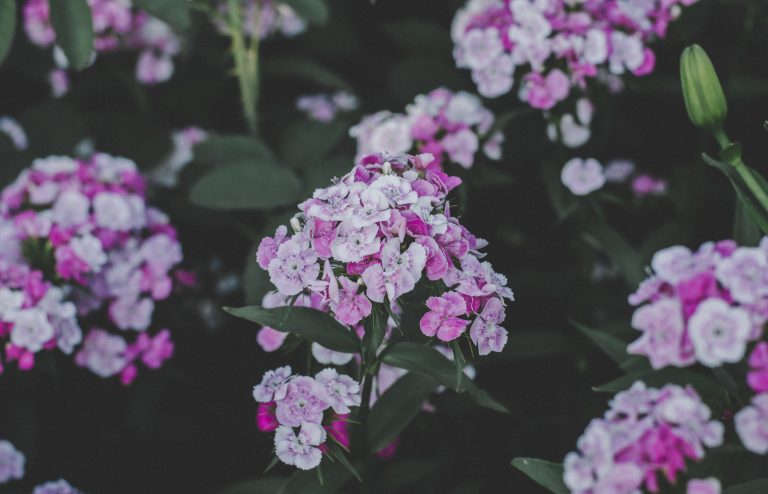How Tall Do Garden Phlox Grow
Phlox are great perennials and have become a firm favourite with gardeners. Many types of phlox plants make for excellent ground cover and promise blooms from the early months of spring, right through to the later months of summer. Plus, these pretty plants are fairly easy to plant, grow and care for.
Let's take a closer look at when, where and how to plant phlox flowers.
Jump To a Section Below
- How To Grow Phlox
- When To Plant Phlox
- Where To Plant Phlox
- How To Plant Phlox
- How To Care For Phlox Plants
- Common Questions on Phlox Plants
- When do phlox flowers bloom?
- Does phlox like sun or shade?
- Does phlox come back every year?
- How quickly does phlox spread?
- Does phlox bloom all summer?
- Is phlox poisonous to dogs?
- What should I do with my phlox after flowering?
- Should you deadhead phlox?
How To Grow Phlox
 Like many other low growing plants, phlox is fairly easy to grow. Consider the following factors when planting your flowers or phlox seeds:
Like many other low growing plants, phlox is fairly easy to grow. Consider the following factors when planting your flowers or phlox seeds:
When To Plant Phlox
Phlox will perform best when planted in the springtime, once the threat of frost has passed.
Where To Plant Phlox
Space your phlox plants out by one to two feet. If you are planning on moving a plant from a pot and planting it in the garden, plant it in a hole that's about twice the size of the pot's diameter.
Then, place the plant so that the tops of the roots are even with the soil's surface. Ensure that your phlox's planting site has rich, evenly moist and well-draining soil.
How To Plant Phlox
Start by using a garden fork or tiller to prepare your garden bed. You can loosen the soil to about 12 to 15 inches deep.
Next, mix in a layer of compost that's between two and four inches.
Lay your phlox into the ground, paying careful attention to making sure they are spaced out by between one to two feet.
Water your phlox plants regularly, especially while they are trying to establish themselves.
How To Care For Phlox Plants
Aside from their beautiful flowers, one of the nicest things about phlox plants is the fact that they're so easy to care for and such low maintenance. They also work well with numerous other plants and complement just about any garden without taking over.
If your area receives less than one inch of rain within a week, be sure to water your phlox plants regularly throughout the hotter months of spring and summer. When spring approaches, make sure that you apply a thin layer of compost, as well as a two-inch layer of mulch, around your phlox plant. This will help keep the soil around it moist, as well as control the weeds.
Once you start to see dead or faded flowers, remove them to encourage your phlox plant to rebloom. If you have a phlox plant that's a bit on the tall side, cut the stems back by roughly one to two inches above the soil.
Garden pests such as powdery mildew, leaf spots, caterpillars and leaf miners, to name a few, are common problems when it comes to phlox. However, you can divide your phlox every two to three years to help reduce the risk of any of these issues.
Common Questions on Phlox Plants

Let's take a look at some of the answers to the most frequently asked questions about phlox plants.
When do phlox flowers bloom?
There are different varieties of phlox flowers and they all bloom at different times.
Taller phlox flowers, which can reach anywhere from 10 inches to four feet in height, tend to bloom throughout summer. There are also a few varieties of phlox that bloom in the springtime. However, most notably unique in bloom time are the Astoria and Intensia varieties. These tend to bloom beautifully even into the later months of autumn, and in some climates, even throughout winter.
Does phlox like sun or shade?
Phlox plants have always been said to be very low maintenance and their growing conditions are reflective of those. Phlox tends to prosper in cool, sunny climates with well-watered soil. However, they will also perform very well in full sun or even partial shade.
In general, most varieties of phlox need at least six hours in direct sunlight every day. On the other hand, if you live in a very hot climate and are thinking of planting phlox plants, make sure that you do so in partial shade.
Does phlox come back every year?
Phlox is an easy-to-grow perennial that will come back reliably every year, given the correct growing conditions.
How quickly does phlox spread?
Phlox is a very reliable perennial that makes for excellent ground cover and blooms masses of flowers throughout springtime. But the plant is not at all aggressive. In average conditions, the plant will grow at a slow to moderate rate, so the chances of it quickly spreading throughout the rest of the garden are very low.
Does phlox bloom all summer?
There are many different varieties of phlox and all of them bloom according to varying schedules. Some kinds of phlox flowers bloom in spring and will continue to bloom right into the summer.
Is phlox poisonous to dogs?
If you have pets, you can go ahead and plant phlox flowers without any concern. Neither the plant nor phlox seeds are dangerous to pets. Even if your dog does ingest some, it's unlikely that it will experience any kind of discomfort at all.
What should I do with my phlox after flowering?
Due to the fact that phlox is a perennial, its flowers will grow back every year. It's best to cut the foliage short right after the first frost spells as it can very quickly turn black if left on the plant. You can further protect the plant by applying a fair layer of mulch to the ground around it.
Should you deadhead phlox?
These plants will reseed themselves but deadheading them will prevent a lot of that reseeing.
Deadheading is often used by gardeners as a tactic to confine the spread of the plant, but this could result in any future seedlings becoming too weedy and not blooming. On the other hand, deadheading your phlox will allow the plant to focus on blooming and keeping the main crown healthy.
There are benefits to deadheading your phlox and to not doing so – you can decide what's best based on your gardening needs.
Phlox is well known for its airy foliage and bright little flowers. They are lesser-known for their sweet, heavenly scent, but this makes them appealing too. Perfectly pretty and available in shades of pink, pale blue, violet, bright red or white flowers, phlox will add a stunning splash of colour to any garden it grows in.

How Tall Do Garden Phlox Grow
Source: https://trulyexperiences.com/blog/growing-phlox/
Posted by: morristhoures.blogspot.com

0 Response to "How Tall Do Garden Phlox Grow"
Post a Comment